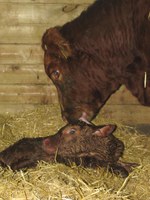Delaying Calving Season Could Decrease Calf Deaths
(Click the image below to view a high-resolution image that can be downloaded)
With spring finally arriving in North Dakota, green grass is showing and many ranchers are focused on moving cow-calf pairs onto grass.
Now is the time to make note of the cows that are not raising calves says Karl Hoppe, North Dakota State University Extension livestock systems specialist at the Carrington Research Extension Center.
A 4% to 5% calf-death loss from birth to weaning is average for North Dakota beef cow herds.
“Because producing a live calf is paramount to a profitable cow-calf operation, management should record and reflect on why cows lost their calves,” says Hoppe. “Death losses that are above average need to be reviewed and management changes considered.
“Cows that didn’t breed or aborted after pregnancy testing are best placed in the cull pen. If these cows have not been showing heat, then check for early pregnancies. While most herds have cows separated from bulls after breeding season, the occasional bull jumps the fence and we fail to record the encounter for future reference.”
Cows that lost live-born calves need to be assigned a cause of death, says Hoppe. If the majority of deaths were related to extreme weather events, consider moving the calving date to a warmer month or building maternity housing.
If the deaths were a result of covered adverse weather events, the U.S. Department of Agriculture’s livestock indemnity program could provide financial assistance to eligible producers for livestock death losses.
“Calves that died due to scours and pneumonia indicate an environmental issue and/or a passive immunity issue,” says Gerald Stokka, NDSU Extension veterinarian and livestock stewardship specialist. “Cold, wet, windy weather and muddy conditions are stressful to a calf. Even an apparently healthy calf exposed to adverse weather can get sick.”
Calf shelters can provide relief from wind, snow and rain, but they also can increase contact between calves and spread sickness. Extreme weather events can lead to disruption of normal nursing which may lead to over consumption of milk and digestive upset.
Weather-related sickness can be reduced by moving to a warmer time of year to calve, says Stokka.
Cows in thin body condition may not have enough good quality colostrum to provide adequate passive immunity transfer to the calf. Cows with large udders and enlarged teats may prevent the calf from figuring out where to nurse and eventually, either nurse too late to get good immunity, or die due to a failure to nurse.
Stokka adds, if coccidiosis or cryptosporidium are causing calf death, then consider reducing environmental stress. Avoid calving in muddy lots, use generous bedding, or consider changing the timing of calving so that a pasture-based system could be used.
“With breeding season starting soon, delaying bull turnout might be helpful if adverse weather caused the majority of a rancher’s calf-death loss,” Hoppe concludes. “The reality is that with cold weather increasing the risk of death loss, the solution is either to calve in a clean barn or calve in warmer weather.”
NDSU Agriculture Communication – May 31, 2019
| Source: | Karl Hoppe, 701-652-2951, karl.hoppe@ndsu.edu |
|---|---|
| Source: | Gerry Stokka, 701-231-5082, gerald.stokka@ndsu.edu |
| Editor: | Kelli Anderson, 701-231-6136, kelli.c.anderson@ndsu.edu |


